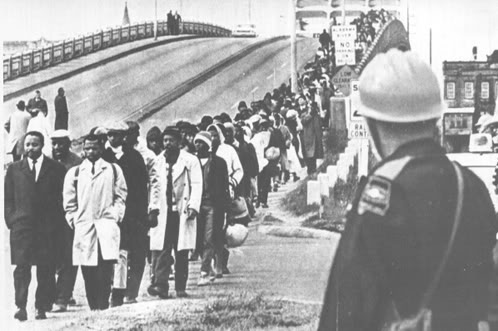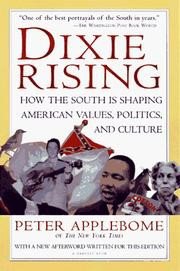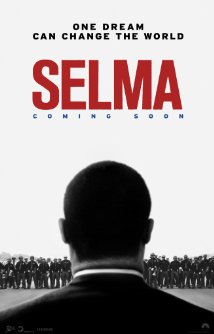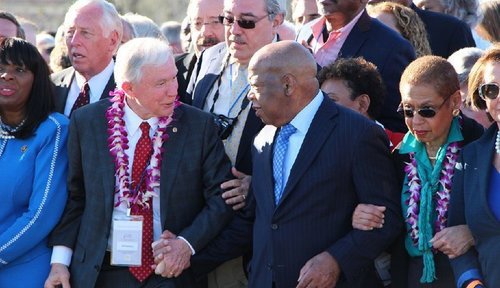![]() With a couple of Tweets, President-elect Donald Trump has changed the world. After Georgia Democrat Rep. John Lewis, always ritually described by the Main Stream Media as a “Civil Rights icon,” attacked his impending presidency as "illegitimate” and refused to attend the inauguration, Trump responded as only he can—and in the process exposed the Civil Rights myth that has paralyzed U.S. political debate for more than five decades.
With a couple of Tweets, President-elect Donald Trump has changed the world. After Georgia Democrat Rep. John Lewis, always ritually described by the Main Stream Media as a “Civil Rights icon,” attacked his impending presidency as "illegitimate” and refused to attend the inauguration, Trump responded as only he can—and in the process exposed the Civil Rights myth that has paralyzed U.S. political debate for more than five decades.
Trump tweeted to his 19.9 million followers:
Congressman John Lewis should spend more time on fixing and helping his district, which is in horrible shape and falling apart (not to mention crime infested) rather than falsely complaining about the election results. All talk, talk, talk—no action or results. Sad!
Of course, hysteria ensued. But twelve hours later Trump was still not backing down:
![]()
Civil Rights Icon Lewis, as we all know, is the living legend who liberated Selma and all of America from white supremacist rule by marching across the Edmund Pettus Bridge and ignoring an order to disperse on “Bloody Sunday,’ March 7, 1965. Lewis even has admirers among VDARE.com Democrats—e.g. Donald A. Collins, who however is puzzled that Lewis now supports “comprehensive immigration reform” i.e. an Amnesty/ Immigration Surge, despite immigration’s devastating impact on blacks.
Needless to say, #NeverTrump leader and Conservatism Inc. Tone Policeman, Bill Kristol, was appalled by Trump’s daring to challenge Civil Rights Icon Lewis:
He Tweeted:
Can't load tweet https://twitter.com/BillKristol/status/820271959799803905: Unknown MIME type: text/html
My view as a young white Southerner born long after the Civil Rights Era: Lewis deserves no respect from anyone who wants to Make America Great Again—because his march in Selma was instrumental in setting America on its current trajectory toward calamity. Equally, it is Kristol’s status as a gatekeeper that has prevented any rational reassessment of the Civil Rights Era’s legacy.
As I pointed out on VDARE.com at the time of the much-hyped 50th anniversary of “Bloody Sunday” in 2015, what is missing from conventional public debate is what happened after the reporters left—what Paul Harvey used to call “The Rest Of The Story.” This is universally the case in the U.S., but especially about the South—see here and here Etc.
The Truth About Selma, my latest book, dares to broach this forbidden subject: what became of the city of Selma, perpetually stuck in 1965 in the eyes of white liberals who hero-worship Lewis as some sort of deity?
The answer: Trump is right.
Whites have fled Selma. Racially balanced in 1960, it is now a ruin, 80 percent black and tipping quickly, with a population down over 30%. It elected a black mayor for the first time in 2000,. And is now run almost entirely by black elected officials. But
Dallas County [dominated by Selma] was the poorest in Alabama last year, with unemployment double the state and national average. More than 40 percent of families live below the poverty line. The violent crime rate is five times the state average.
[Fifty Years After Bloody Sunday in Selma, Everything and Nothing Has Changed, , By Ari Berman, The Nation, February 25, 2015]
Indeed, Selma is now one of America's most dangerous cities according to CityData.com. NeighborhoodScout.com rates Selma with a crime index of zero, which somewhat counterintuitively means the city is safer than 0% of the cities in the US.
Because of shockingly high rates of black-on-black crime—as well as just black criminality—the city launched a "No More" campaign:
![]() Selma city officials are launching an anti-violence campaign after an 18-year-old high school student was fatally shot in an armed robbery.
Selma city officials are launching an anti-violence campaign after an 18-year-old high school student was fatally shot in an armed robbery.
Selma Mayor George Evans announced the initiative yesterday during the funeral service for Alexis Hunter, who was shot to death last weekend.
The campaign will urge every resident, business and organization to post signs with the words “no more” written on them
[Selma City Officials to Launch an Anti-Violence Campaign After an 18-year-old Was Fatally Shot, WAKA.com, January 13, 2013]; [Effort aims to ‘heal our land’,, Selma Times Journal, January 4, 2014].
If you read between the lines, disillusion with the results of the “Civil Rights Revolution” was already apparent more than 20 years ago:
The racial violence of the past is largely gone, replaced by a flood of drug-related, black-on-black crime that dwarfs the violence of Jim Crow.
[In Selma, everything and nothing has changed, by Peter Applebome, August 2, 1994. Emphasis added]
![]() In his 1996 book Dixie Rising: How the South is Shaping American Values, Politics and Culture, Peter Applebome quoted Bob Mants, a black man who participated in the same “Bloody Sunday” march that Lewis uses as his meal ticket to this day:
In his 1996 book Dixie Rising: How the South is Shaping American Values, Politics and Culture, Peter Applebome quoted Bob Mants, a black man who participated in the same “Bloody Sunday” march that Lewis uses as his meal ticket to this day:
"You have black faces in high places in public office, but people may be poorer now than when I came here in 1965. I thought back then if there was anyplace I wanted to raise my kids it would be here, because they could see black people moving forward, advancing themselves as a race. I was naive. The progress hasn't taken place."
But as George Orwell put in in his dystopian novel 1984: "He who controls the present, controls the past; he who controls the past, controls the future…" The extraordinary Ruling Class sacralization of both Selma and John Lewis has ensured no one dared challenged the Civil Rights myth so carefully positioned as one of the defining moments in American history…until Trump.
![]() Thus Lewis was one of the characters featured in Selma, the celebrated 2015 movie culminating in not only Academy Awards, but a cherished piece of social activism. A DVD copy of the movie was disseminated to every public and private school in America (courtesy of Paramount Home Media Distribution). [ Every High School In The U.S. Will Be Sent A Copy Of 'Selma', by Natalie Robehmed, Forbes.com, April 24, 2015]
Thus Lewis was one of the characters featured in Selma, the celebrated 2015 movie culminating in not only Academy Awards, but a cherished piece of social activism. A DVD copy of the movie was disseminated to every public and private school in America (courtesy of Paramount Home Media Distribution). [ Every High School In The U.S. Will Be Sent A Copy Of 'Selma', by Natalie Robehmed, Forbes.com, April 24, 2015]
TeachWithMovies.com offered a free, downloadable lesson guide for the movie. Bazaned.com offered teachers a Selma curriculum guide to teach middle and high school students in America the importance of the movie and how the events it celebrates were instrumental in ensuring the Voting Rights Act was passed.
![]() Incredibly, John Lewis is even a comic superhero greater than Batman and Superman, whose exploits are too great for just one story, but must be told in March, March: Book Two, and March: Book Three.
Incredibly, John Lewis is even a comic superhero greater than Batman and Superman, whose exploits are too great for just one story, but must be told in March, March: Book Two, and March: Book Three.
![]()
All have been huge sellers, with the first issue gracing the New York Times Bestseller list for 52 weeks.
The series, which has received the Eisner Award, paints Lewis as a superhero, greater than anything Stan Lee or Jack Kirby could have imagined. The graphic novel has been introduced as a textbook in New York City Public school classrooms even, part of the official "Passport to Social Studies" curriculum." [Rep. John Lewis: A hero in civil rights—and comic books, by Sofiya Ballin, Philly.com, August 16, 2016]
Though Lewis never served in the Navy or even learned to swim (a fact he is quick to blame on segregated pools in his native Troy, Alabama), the Obama Administration just named a U.S, Navy replenishment oiler named in his honor:
![]() "As the first of its class, the future USNS John Lewis will play a vital role in the mission of our Navy and Marine Corps while also forging a new path in fleet replenishment," said [Obama Navy Secretary Ray] Mabus. "Naming this ship after John Lewis is a fitting tribute to a man who has, from his youth, been at the forefront of progressive social and human rights movements in the U.S., directly shaping both the past and future of our nation."
"As the first of its class, the future USNS John Lewis will play a vital role in the mission of our Navy and Marine Corps while also forging a new path in fleet replenishment," said [Obama Navy Secretary Ray] Mabus. "Naming this ship after John Lewis is a fitting tribute to a man who has, from his youth, been at the forefront of progressive social and human rights movements in the U.S., directly shaping both the past and future of our nation."
According to Lewis' office, all of the ships within this class of fleet replenishment oilers will be named after Civil Rights heroes
[New Navy Ship Will Be Named After Civil Rights Icon John Lewis, by Mashaun D. Simon, NBC News, January 6, 2016. Italics added]
Despite all this Establishment fawning, it should be noted that Lewis remains an intensely partisan Leftist (as, of course, was Martin Luther King). Thus when America’s Senator, Selma native Jeff Sessions, was nominated by Trump to be Attorney General, he was attacked by Lewis in unbridled terms:
Rep. John Lewis, who led the 1965 “Bloody Sunday” march across the Edmund Pettus Bridge in Selma, Alabama, said Mr. Sessions’ law-and-order rhetoric stoked fear of a return to police beatings of blacks who challenged segregation or sought to vote.
“Those who are committed to equal justice in our society will wonder whether Senator Sessions’ call for law and order means today what it meant in Alabama when I was growing up."
[ Jeff Sessions smeared by Cory Booker and John Lewis at confirmation hearing, By S.A. Miller, Washington Times, January 11, 2017]
![]() Note that Sessions had groveled in 2015 by going to the 50th anniversary celebration of the march across the bridge —photographed walking arm and arm with Lewis himself! Sessions even issued a press release celebrating he marchers’ achievements and spearheaded the campaign for them to be awarded the Congressional Gold Medal. [Sessions Helps Spearhead Congressional Gold Medal For Selma Marchers, Sessions.Senate.Gov, , March 6, 2015]
Note that Sessions had groveled in 2015 by going to the 50th anniversary celebration of the march across the bridge —photographed walking arm and arm with Lewis himself! Sessions even issued a press release celebrating he marchers’ achievements and spearheaded the campaign for them to be awarded the Congressional Gold Medal. [Sessions Helps Spearhead Congressional Gold Medal For Selma Marchers, Sessions.Senate.Gov, , March 6, 2015]
But groveling did him no good. In what I have called Black-Run America, groveling will never do whites any good. The unifying theme of our political class, entertainment industry and academia: exploiting what happened in 1965 Selma as the permanent justification for imposing greater and greater anti-white measures as law.
But it’s all a lie, as you’ll see in The Truth About Selma: without “law and order” – the bedrock of any civilization – you get the community found in 2017 Selma, an 80 percent black city whose black leadership pleads with citizens to place yard signs reading “No More.”
Trump made it clear he is a “law and order” man. And, incredibly, he now seems to have shown, with just a few Tweets, that he isn't planning on shadowboxing with the Left at all.
Paul Kersey[Email him] is the author of the blog SBPDL, and has published the books SBPDL Year One, Hollywood in Blackface and Escape From Detroit, Opiate of America: College Football in Black and White and Second City Confidential: The Black Experience in Chicagoland. His latest book is The Tragic City: Birmingham 1963-2 013.




 With a couple of Tweets, President-elect Donald Trump has changed the world. After Georgia Democrat Rep. John Lewis, always ritually described by the Main Stream Media as a “
With a couple of Tweets, President-elect Donald Trump has changed the world. After Georgia Democrat Rep. John Lewis, always ritually described by the Main Stream Media as a “
 Selma city officials are launching an anti-violence campaign after an 18-year-old high school student was fatally shot in an armed robbery.
Selma city officials are launching an anti-violence campaign after an 18-year-old high school student was fatally shot in an armed robbery.


 Incredibly, John Lewis is even a comic superhero greater than Batman and Superman, whose exploits are too great for just one story, but must be told in March, March: Book Two, and March: Book Three.
Incredibly, John Lewis is even a comic superhero greater than Batman and Superman, whose exploits are too great for just one story, but must be told in March, March: Book Two, and March: Book Three. 
 "As the first of its class, the future USNS John Lewis will play a vital role in the mission of our Navy and Marine Corps while also forging a new path in fleet replenishment," said [
"As the first of its class, the future USNS John Lewis will play a vital role in the mission of our Navy and Marine Corps while also forging a new path in fleet replenishment," said [ Note that Sessions had groveled in 2015 by going to the 50th anniversary celebration of the march across the bridge —
Note that Sessions had groveled in 2015 by going to the 50th anniversary celebration of the march across the bridge —








